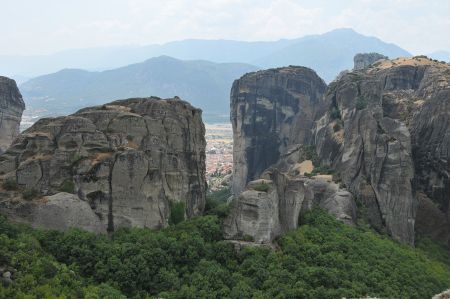Meteora - climbing in unusual rock geology
- Written by Portal Editor
We were again on the way to Meteora, because a national, Greek Climbing Festival will take place on the mountain pillars and at Camping Vrachos on the next weekend that had caught our attention.
From all parts of Greece climbers and nature enthusiasts will arrive, mostly with Annex and family, to comply with their favorite recreational activity on the mountains. During our last visit we even had the chance to gain experience at the unusual rock formations and the really interesting climbing routes, but more on that later.
Besides the climbing festival and the monasteries of Meteora we were especially interested in the extraordinary geology of the mountain formations themselves, which seem to have ascended from the ground in such a unique formation as pillars of stone. The explanation of causes of these rock formations is not quite as easy to describe as one thinks at first, because it is not made of hard lava rock similar to those found in other regions. The Meteora rocks consist of a mixture of sandstone and mineral conglomerates, so that sometimes even the impression of artificial rock formations arise, so the comparison with coarse concrete is in some relation quite close.
Researchers however have come to the conclusion in their investigations that the conglomerate has evolved over millions of years by deposits of stone, sand and mud on the edge of the sea, the processes of the region's rock formations have been formed by erosion by water currents after geological rise. What can be understood rather well in the more detailed consideration of the rock, so clearly the floods signed in rock.
About 60 million years ago, during the Paleogene, a series of earth movements for which the seabed along with its water shifted upwards, the water could flow over some vertical fault lines into the thick layer of sandstone and by that created the high plateau. The giant rock columns were then formed by weathering by water and wind and extreme temperatures. It is unusual that this conglomerate formation and type of weathering can only be found in a relatively limited area within the surrounding rock formation.
This type of rock formation and the weathering process is done in other places too, but in Meteora so special, because on the one hand to demonstrate the unity of sedimentary rocks only a few signs of vertical stratification are to be seen and secondly the abrupt, vertical washouts that spans more than 100 meters of rise. In any case, closer inspection is recommended, which is also seen by many visitors that way.
In many places during our newly round trip through the rock formations we could find climbers. There are countless routes with well differentiated climbing routes, which are recorded in a climbing guide. On Camping Vrachos this guidebook is available for inspection. Even an experienced climbing guide is on site, so that you can get technically experienced information or even accompaniment especially for the newcomer to Meteora.
With the arrival at the camp itself, we were very surprised with regard to the huge number of guests, so we did not expect. A large number of climbers from all parts of Greece had gathered for the holiday weekend here, with just the "family" together was brought to the fore. So there was meeting of young families with children, organized so that even the climbing itself was not neglected. Supervision for the children was easily controlled: Today I, tomorrow you! Just great. Dinner was cooked and eaten together and here the children were involved again. So there was hustle and bustle throughout the day, while the climbers were traveling in ever new group constellations.
In the evening there were organized film and outdoor reports that have been used by many in attendance to exchange ideas, to learn news, or simply just to learn new contacts. In short, a great experience for us, who had not expected such a family group of climbers.
Please read as well:
Crossing the Rio-Andirrio-Bridge to Peloponnes
Traditional Nafpaktos - on the way to Peloponnesus
-
-
-
-
-
-
-
-
-
-
-
-
-
-
-
-
-
-
-
-
-
https://www.alaturka.info/en/greece/trikala/3457-meteora-climbing-in-unusual-rock-geology/amp#sigProId0dca9ef1ab
